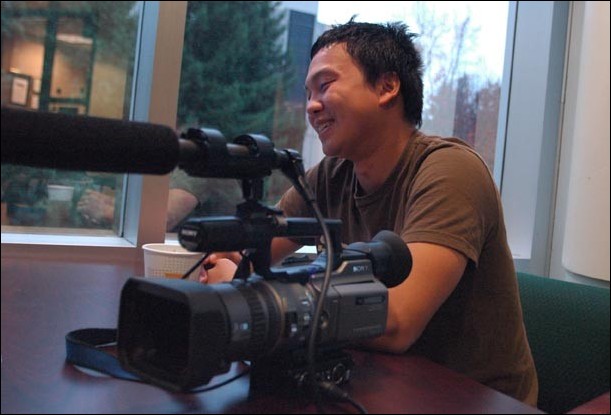Hmong culture through the power of film
Image: Hmong culture through the power of film:Paul Lee Cha, the president of the Hmong University Student Association and a graduate student in the self-created major of Hmong Studies, sits with his camera as he discusses his short film ?The Hmong Journey.? Cha hopes to eventually join the Peace Corp:
November 29, 2006
As Paul Lee Cha chills outside the Associated Students, Inc. office, his smile is genuine as he talks about his upcoming projects, Hmong culture and school. Genuine — that same word can be used to describe Cha in all aspects of life.
It could be said that Cha is ahead of his time, with a vision for the future.
Cha was born in 1982 in Portland, Ore. His family moved to Fresno when he was young, and while he was in middle school he moved to Sacramento.
�I�ve got family all over the west coast,� Cha said. �It�s like, in Hmong culture, we have a cousin that�s a cousin to a cousin and we are all family.�
Cha is a graduate student with a degree in biology. As a graduate student, he has created his own major, Hmong studies. �It involves a mix of anthropology, ethnic studies and sociology classes,� Cha said. �It was really hard to do because I had to have all the faculty in different departments sign off for it.�
Cha plans to get a job in the Peace Corps in China or Thailand. Eventually, he wants to work in a nonprofit organization — either in community development or education.
His dream is to create a nonprofit Hmong cultural center.
Cha recently made an 18-minute film about Hmong history and culture, called �Hmong Journey.� It is being shown in anthropology classes on campus, and was recently uploaded to YouTube.
�My whole life I�ve been looking for something like this,� Cha said. �One day I just got up and did it.�
�It started off as a hobby, but I started to understand the power of media,� Cha said. �You can take emotion, capture it on film, and share it with whomever you want. It�s an effective way to get your message across.�
Cha�s film includes short video clips, audio and excerpts from cassettes his family had sent back and forth when they first came to America in 1980.
�Going through those was really sad,� Cha said. �That was the only way families could communicate during that time because a lot of families that weren�t over to the U.S. yet and were still in refugee camps in Thailand after fleeing from the war in Laos. While our family was over here, it was the only way to communicate. So when people listened to the tapes, they would cry.�
�He�s a genius,� said Doa Vang, a business major and Hmong University Student Association historian. �The audio he used touched everybody. You hear people saying to take care of the family�and people crying. Paul will help anybody, he�s a good guy.�
Cha cites early influences from hearing elder people talk about the old country, before America.
�I pick up bits and pieces, but nothing that is put together in one piece,� Cha said. �I want to go back to China – see the motherland and get a feel for what I�ve heard about it and get to experience it.�
Cha�s inspiration comes mostly from his parents, especially his father.
�My father raised me to be observant of how things are in life,� Cha said. �I learned how to deal with life more�and to always remember who I am and where I came from. He taught me to always have a passion to strive for something.�
In addition to Cha�s talent as a filmmaker, he is the president of the HUSA, which now has between 80 and 90 members.
�I�ve been an active member for four years now,� Cha said. �Our goals at HUSA are to promote higher education and promote cultural awareness.�
�We need someone to put movies together,� said Yia Her a biology major. �He gives the general idea about our culture and around the world. Paul�s impacted us a lot. He�s influenced others to follow in his path and start making videos too.�
The HUSA has been very active. On Saturday, they had their annual Winter Formal dance fundraiser. This past weekend was also the Hmong New Year celebration. There was food, games, crafts, arts and music. It takes place at Cal Expo every year.
�It is the second-biggest Hmong New Year celebration in the country, next to Fresno,� Cha said with a smile. �It�s a place to come together to exchange ideas, have fun and find girls.�
The HUSA also tutors high school students and helps them apply to college. Every year there is a banquet for graduates. In the spring, the club holds a carnival for a lucky elementary school. The HUSA also has study groups for students and provides cultural guest speakers. In addition, the club has a big brother/big sister program for incoming freshmen to help them get accustomed to college.
�HUSA is great for students that don�t know much about Hmong culture or the language,� Cha said. �There is a green dialect and a white dialect. We can understand each other, but it�s just a different dialect from a different region. That is why you see Hmong spelled two different ways.�
Cha emphasized that the club wants people from all cultural backgrounds to check it out. The club is always looking for more members. It�s only $10 to join and you get a lot for your money, Cha said. The club meets on Wednesdays in the University Union.
�Always value who you are,� Cha said. �Understanding that so many people are different made me a better person.�
Galen Kusic can be reached at features@statehornet.com

































































































































